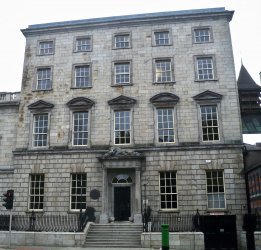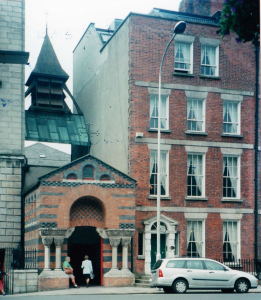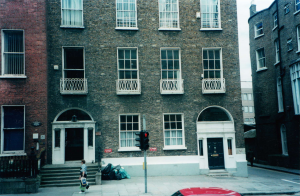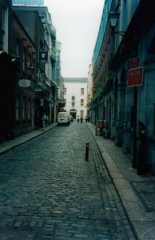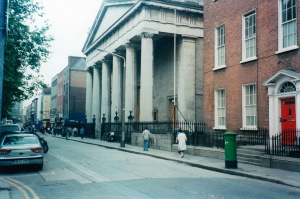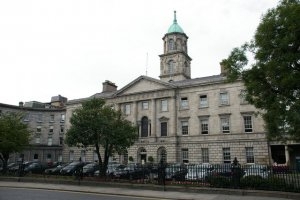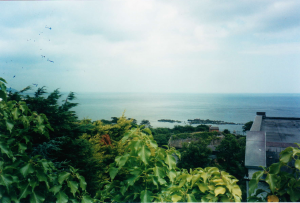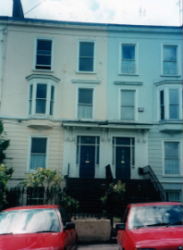John Henry Newman was the guiding light in the establishment of the Catholic University of Ireland from 1851 to 1858.
This map shows significant places where he lived and worked.
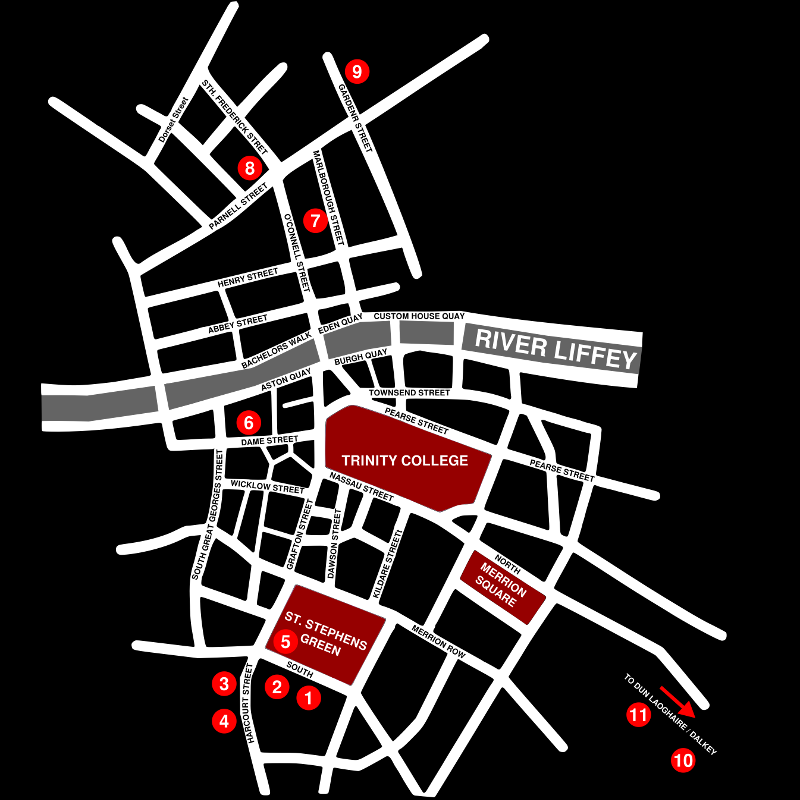
Newman House is one of the great houses of Dublin. The granite front is most handsome and the interior plaster work by Richard West, stuccadore, is of particular importance. The house was built for Richard Chappell Whaley M.P.for County Wicklow. He was commonly known as “Burn-Chapel Whaley” and was a notorious priest hunter.Tradition has it that he swore that no papist would ever darken the door of his house at 86 St. Stephens Green. It is the venue for many postgraduate and other functions of University College Dublin
ST. STEPHENS GREEN
Newman acquired the site for the church in 1855 from a Judge John Ball who lived in 85 St. Stephens Green. He invited John Hungerford Pollen, Professor of Fine Arts in the new university, to design and build it. Newman’s idea was “to build a large barn and decorate it in the style of a basilica, with Irish marbles and copies of standard pictures”. By April 1856 the shell of the church was complete. As the late Fergal McGrath S.J. says “the speed with which the work on the church went forward is almost incredible in our age of highly organised procrastination”. The church, dedicated in May 1856, is a most fascinating mixture of Early Christian and Byzantine and is one of the architectural gems of the 19th century.
6 HARCOURT STREET
When Newman left 16 & 17 Harcourt Street, he moved to number 6. During his time there it was known as St. Mary’s. He had a small chapel at the back of the building of which, unfortunately, no trace remains. The building was the headquarters of Sinn Féin during the War of Independence. It now houses the offices of Conradh na Gaeilge (The Gaelic League).
16 & 17 HARCOURT STREET
In 1852 Newman came to Ireland to deliver his series of lectures entitled “Discourse of the Scope and Nature of University Education”. Initially he stayed at 22 Dorset Street, now sadly demolished. After a fortnight there, he was invited by Dr. James Quinn, a Dublin priest, later Archbishop of Brisbane, Australia, to move to 16 Harcourt Street. Newman was very pleased with his new accommodation. “He offered me a beautiful room with a chandelier and perhaps pagan alto-reliefs on the walls. It opens into another large room, which will almost always be at my service as a reception room.” It was here that his housekeeper rearranged his papers from order of use to order of size.
ENTRANCE TO ST. STEPHENS GREEN, OPPOSITE NEWMAN HOUSE
The entrance to the park is the one which Newman must have frequently used. It is known to the Loreto nuns, who have a house just a few doors away from Newman House, as “Newman’s Way”. It was in the park that Newman met his former friend and mentor of Oxford days, Richard Whately, Church of Ireland Archbishop of Dublin, out walking his dogs, who in refusing to recognise Newman caused him great hurt and pain. The park is very popular with the people of Dublin and in the summer months is a venue for concerts and other events.
CATHOLIC UNIVERSITY MEDICAL SCHOOL, CECILIA STREET
The building facing you at the end of Crow Street is the original site of the medical school which Newman founded in 1855. Newman bought it from the Dublin Apothecaries Hall for £1500. The medical school is one of Newman’s greatest achievements. From its foundation to the present day it has been a great success. The school was formally opened in November 1855 with 36 students on its rolls. It was immediately recognised by the various professional bodies in Ireland, England and Scotland. Newman was very proud of its success. “Did our efforts towards the foundation of a Catholic University issue in nothing beyond the foundation of a Catholic School of Medicine in the metropolis, as it has already done, they would have met with sufficient reward.”
ST. MARY’S PRO-CATHEDRAL, MARLBOROUGH STREET
The building of the Pro- Cathedral began in 1816 before Catholic Emancipation and is situated off O’Connell Street for that reason. It is a curious mixture of Greco-Roman architecture. Sweetman, the architect, is said to have based his design on the Church of St. Philippe-du-Roule in Paris. Newman was solemnly installed as Rector of the Catholic University at the Pro-Cathedral after High Mass by Dr. Moriarty, Bishop of Kerry, in 1854. Newman wrote to his oratorian confrere, Fr. Ambrose St. John, “The church was more crowded than ever known”. There is a very fine statue of Cardinal Cullen, who was responsible for Newman coming to Dublin to establish the Catholic University, on the left entering the church.
THE ROTUNDA MATERNITY HOSPITAL, PARNELL STREET
The first lying-in hospital in Ireland or the United Kingdom was founded by Bartholomew Mosse in 1757. Newman delivered his first series of lectures in the Rotunda Assembly Rooms which are now part of the hospital (right of the picture, behind the trees). During his lecture he was discommoded by the band of the 81st Regiment playing at a St. Vincent de Paul Bazaar in a nearby room. He was, however, pleased with his lecture: “the lecture, I suppose thanks to Our Lady, has been a hit”.
THE JESUIT CHURCH, ST. FRANCIS XAVIER’S, UPPER GARDINER STREET
While staying in Dorset Street, which is close to Upper Gardiner Street, Newman celebrated Mass in St. Francis Xavier’s Church. After Mass it was his custom to breakfast in the Jesuit Fathers’ house next door. The church is in the Baroque style and has a splendid Italian high altar. The tomb of the saintly John Sullivan S.J., also a convert, is located to the left of the church as you enter. It is from this church that the funeral of Gerard Manley Hopkins S.J., to Glasnevin Cemetery, took place.
MOUNT SALUS, DALKEY, CO. DUBLIN
Mount Salus is a handsome building where Newman and other members of the Birmingham Oratory stayed in September and October 1854. Newman was delighted with it. He wrote “Tastes so differ, that I do not like to talk, but I think this is one of the most beautiful places I ever saw”. He availed of it also to offer some respite to Father Faber and the Oratorian community in London, where there was a cholera epidemic. Newman was pleased with the felicitous name of Mount Salus.
CROSTHWAITE TERRACE, DUN LAOGHAIRE
Sometime in 1854 Newman and his Oratorian colleague, Fr. Ambrose St. John, spent a few weeks at No. 2 Crosthwaite Terrace, which was the residence of Henry Wilberforce, while searching for a suitable holiday location in Ireland for himself and members of the Birmingham Oratory community. This area became known as Kingstown, following the visit of King George IV in 1821. It has now reverted to its original name, Dun Laoghaire. It was accessible from Dublin, five and a half miles away, by means of Ireland’s first commuter railway which was established in 1834.



